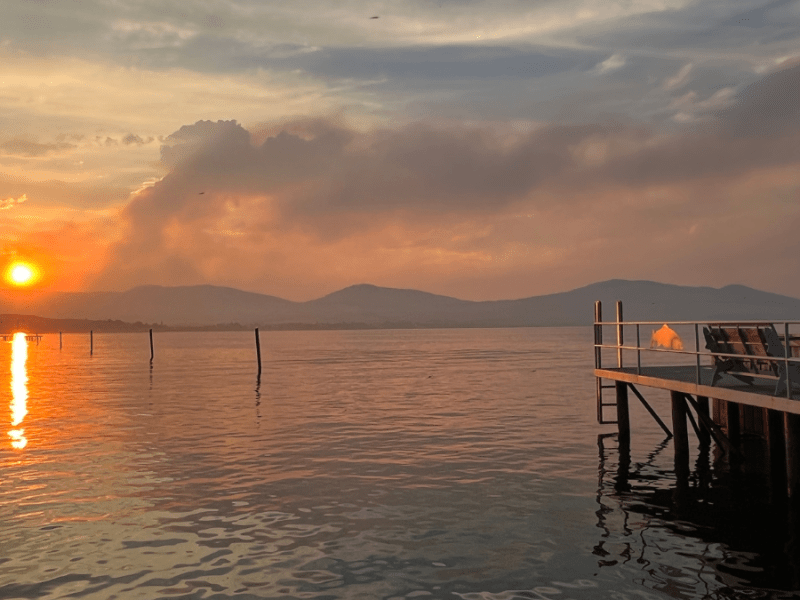Montana Rep. Ryan Zinke has introduced legislation demanding that water managers keep Flathead Lake full from June 15 to Sept.15, following a summer of low water levels on the West’s largest freshwater lake.
The “Fill the Lake Act” is meant to address problems that Zinke said were “exacerbated by the slow-working bureaucracy” this past summer. But others blamed the low water levels on something much bigger: drought and climate change.
Flathead Lake usually starts the year at its lowest level, approximately 2,884 feet datum (the standard measure to gauge water levels in lakes), and begins to fill up in April and May, hitting the full pool at 2,893 feet in June. The lake usually stays within a foot of that until after Labor Day. But this past spring, the lake never hit its normal “full” depth and began to drop again by mid-June. By July, it was two feet lower than normal.
Brian Lipscomb is CEO of Energy Keepers Inc., the company that manages Séliš Ksanka QÍispé Dam (formally Kerr Dam) for its owner, the Confederated Salish and Kootenai Tribes. In July, he attributed the historically low water level to a less-than-stellar snowpack that melted early because of a burst of warm weather in the spring. Northwest Montana also got little rain, and, according to the U.S. Drought Monitor, January to May 2023 was the fifth driest start to the year in Flathead County since it started keeping records 129 years ago. By July, managers of the dam near Polson were releasing the minimum amount of water they legally could to protect fish species downstream.
As the lake’s water level dropped, it impacted dock and business owners who blamed water managers for the hit to recreation and the local economy. During a series of well-attended “Save Flathead Lake” meetings, organizers criticized federal and tribal officials, saying more water could have been held back earlier in the year. Some elected officials suggested that more water be released from the Hungry Horse Dam to alleviate the issue, but that plan was torpedoed by the Columbia River Technical Management Team due to environmental concerns.
RELATED
What’s to blame for too little water in Flathead Lake: climate or mismanagement?
The dam-managed lake at the headwaters of the Columbia River system was on Aug. 10 more than 2 feet below “full pool,” or the ideal level for using the lake’s numerous docks and ramps. Accusations of mismanagement have been flying while the dam operators point to the role of a rapid runoff of a modest snowpack.
As summer heats up, impacts of drought begin to appear in northwest Montana
In the last month, Flathead Lake has dropped more than a foot, and by July 12 it is expected to be 22 inches below full pool. In an area heavily reliant on tourism, the drop has frustrated people who make their livelihood on the water and some business owners are worried they’re going to have to lay workers off before the summer is over.
Zinke’s proposed “Fill the Lake Act” would require the Department of the Interior to keep the depth of Flathead Lake between 2,892 and 2,893 feet between June 15 and Sept. 15.
“This is a made-in-Montana solution. Fill the lake is a one-page bill — and it should be — it’s not a difficult concept,” Zinke said in a press release. “Hungry Horse Reservoir exists for the management of water downstream, and that means Flathead Lake. Unfortunately, the delays and bureaucracy created by the Department of the Interior and the technical management team made a bad situation even worse. This bill takes out the ambiguity and forces the Department and its unelected bureaucrats to do their most basic job so that Montanans don’t suffer from their mistakes again.”
The bill does not, however, address what would happen if Northwest Montana experiences another hot and dry spring, or if it would allow the dam to release less water than it is legally required to. However, the legislation has the support of local leaders around the lake, including members of the Flathead and Lake county commissions.
“At a local level, we rely on the lake for fundamental operations to keep our people safe. Our lake levels need to be consistent, which is why I fully support Zinke’s Fill the Lake Act,” Lake County Commissioner Gale Decker said in a press release.
The legislation, which had yet to receive a bill number on Wednesday, will first be assigned to a House committee. If it eventually passes out of the committee and the full House, it would then move to the Democratically-controlled Senate.

In-depth, independent reporting on the stories impacting your community from reporters who know your town.
LATEST STORIES
The race to be the partisan clerk of Montana’s nonpartisan Supreme Court
The clerk of the Montana Supreme Court is a unique position. Unlike the actual justiceships on the high court, the clerkship is partisan. And unlike almost every other state supreme court clerk in the country, Montana’s is elected.
Second Montana ski resort looks to turn wastewater into powder
More than a dozen ski areas in eight states, plus some in Canada, Switzerland and Australia, use wastewater to make powder. This past winter, the Yellowstone Club near Big Sky became the first in Montana to turn what was once sewage into snow.
What is a Supreme Court clerk, anyway?
PLUS: Who wants a special session?




